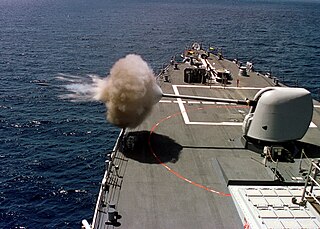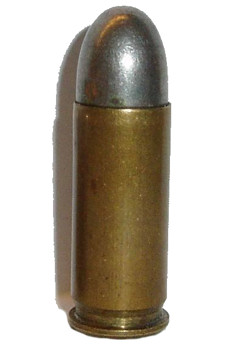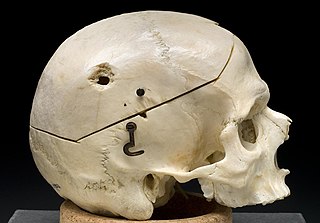The field of wound ballistics largely comprises the study of the physical and physiological effects of ballistic trauma by projectiles (primarily, but not exclusively, bullets) on living humans or animals. It can be considered the interdisciplinary intersection of trauma medicine and terminal ballistics.

Hydrostatic shock is the controversial concept that a penetrating projectile can produce a pressure wave that causes "remote neural damage", "subtle damage in neural tissues" and "rapid incapacitating effects" in living targets. It has also been suggested that pressure wave effects can cause indirect bone fractures at a distance from the projectile path, although it was later demonstrated that indirect bone fractures are caused by temporary cavity effects.

A bullet is a kinetic projectile, a component of firearm ammunition that is shot from a gun barrel. They are made of a variety of materials, such as copper, lead, steel, polymer, rubber and even wax; and are made in various shapes and constructions, including specialized functions such as hunting, target shooting, training, and combat. Bullets are often tapered, making them more aerodynamic. Bullet size is expressed by weight and diameter in both imperial and metric measurement systems. Bullets do not normally contain explosives but strike or damage the intended target by transferring kinetic energy upon impact and penetration.

Terminal ballistics is a sub-field of ballistics concerned with the behavior and effects of a projectile when it hits and transfers its energy to a target.

Ballistics is the field of mechanics concerned with the launching, flight behaviour and impact effects of projectiles, especially ranged weapon munitions such as bullets, unguided bombs, rockets or the like; the science or art of designing and accelerating projectiles so as to achieve a desired performance.

This is a table of selected pistol/submachine gun and rifle/machine gun cartridges by common name. Data values are the highest found for the cartridge, and might not occur in the same load.

The .40 S&W is a rimless pistol cartridge developed jointly by American firearms manufacturers Smith & Wesson and Winchester in 1990. The .40 S&W was developed as a law enforcement cartridge designed to duplicate performance of the Federal Bureau of Investigation's (FBI) reduced-velocity 10mm Auto cartridge which could be retrofitted into medium-frame semi-automatic handguns. It uses 0.40-inch (10 mm) diameter bullets ranging in weight from 105 to 200 grains.

External ballistics or exterior ballistics is the part of ballistics that deals with the behavior of a projectile in flight. The projectile may be powered or un-powered, guided or unguided, spin or fin stabilized, flying through an atmosphere or in the vacuum of space, but most certainly flying under the influence of a gravitational field.

Ballistic gelatin is a testing medium designed to simulate the effects of bullet wounds in animal muscle tissue. It was developed and improved by Martin Fackler and others in the field of wound ballistics. It is calibrated to match pig muscle, which is ballistically similar to human muscle tissue.

A gunshot is a single discharge of a gun, typically a man-portable firearm, producing a visible flash, a powerful and loud shockwave and often chemical gunshot residue. The term can also refer to a ballistic wound caused by such a discharge.

The .44 Remington Magnum, also known as .44 Magnum or 10.9x33mmR, is a rimmed, large-bore cartridge originally designed for revolvers and quickly adopted for carbines and rifles. Despite the ".44" designation, guns chambered for the .44 Magnum round, its parent case, the .44 Special, and its parent case, the .44 Russian all use 0.429 in (10.9 mm) diameter bullets. The .44 Magnum is based on the .44 Special case but lengthened and loaded to higher pressures for greater velocity and energy.
Stopping power is the ability of a weapon – typically a ranged weapon such as a firearm – to cause a target to be incapacitated or immobilized. Stopping power contrasts with lethality in that it pertains only to a weapon's ability to make the target cease action, regardless of whether or not death ultimately occurs. Which ammunition cartridges have the greatest stopping power is a much debated topic.

In ballistics, the ballistic coefficient of a body is a measure of its ability to overcome air resistance in flight. It is inversely proportional to the negative acceleration: a high number indicates a low negative acceleration—the drag on the body is small in proportion to its mass. BC can be expressed with the units kilograms per square meter (kg/m2) or pounds per square inch (lb/in2).
Handgun effectiveness is a measure of the stopping power of a handgun: its ability to incapacitate a hostile target as quickly and efficiently as possible.

The .38 ACP, also known as the .38 Auto or 9x23mmSR, is a semi-rimmed pistol cartridge that was introduced at the turn of the 20th century for the John Browning-designed Colt M1900. It was first used in Colt's Model 1897 prototype, which he did not produce. The metric designation for the round is 9×23mm SR (semi-rimmed), which is not to be confused with other 9×23mm cartridges.
A very-low-drag bullet (VLD) is primarily a small arms ballistics development of the 1980s–1990s, driven by the design objective of bullets with higher degrees of accuracy and kinetic efficiency, especially at extended ranges. To achieve this, the projectile must minimize air resistance in flight. Usage has been greatest from military snipers and long-range target shooters, including F-class and benchrest competitors, but hunters have also benefited. Most VLD bullets are used in rifles. VLD bullets typically have a ballistic coefficient greater than 0.5, although the threshold is undefined.

A gunshot wound (GSW) is a penetrating injury caused by a projectile from a gun. Damages may include bleeding, bone fractures, organ damage, wound infection, loss of the ability to move part of the body and, in severe cases, death. Damage depends on the part of the body hit, the path the bullet follows through the body, and the type and speed of the bullet. Long-term complications can include bowel obstruction, failure to thrive, neurogenic bladder and paralysis, recurrent cardiorespiratory distress and pneumothorax, hypoxic brain injury leading to early dementia, amputations, chronic pain and pain with light touch (hyperalgesia), deep venous thrombosis with pulmonary embolus, limb swelling and debility, lead poisoning, and post-traumatic stress disorder (PTSD).

Penetrating trauma is an open wound injury that occurs when an object pierces the skin and enters a tissue of the body, creating a deep but relatively narrow entry wound. In contrast, a blunt or non-penetrating trauma may have some deep damage, but the overlying skin is not necessarily broken and the wound is still closed to the outside environment. The penetrating object may remain in the tissues, come back out the path it entered, or pass through the full thickness of the tissues and exit from another area.

Sectional density is the ratio of an object's mass to its cross sectional area with respect to a given axis. It conveys how well an object's mass is distributed to overcome resistance along that axis.
Backyard Ballistics is a how-to book by William Gurstelle that was published in 2001. It is full of experiments that can be done relatively inexpensively and can be easily executed. It also includes the history and mechanical principles of some of the inventions and projects. From catapults to rockets, this book describes accessible ways to create these at home or in the classroom. In addition to recreational use by individuals, teacher's guides have been developed and science fair projects designed around this book. It has been cited in several educational and scientific journals.

Ipsita Biswas is an Indian terminal ballistics scientist. In 2019 she was conferred India's highest civilian award for women, the Narishakti Puruskar, for her contributions to India's armed forces, paramilitary forces and women's empowerment in defence research and development.